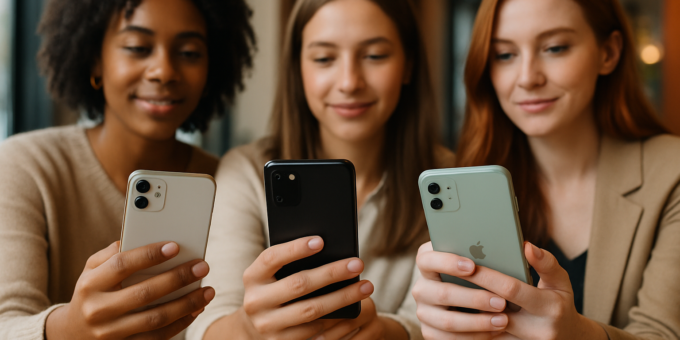
In an era where smartphones are the lifelines of both our professional and personal lives, battery life isn’t just a luxury—it’s a necessity. Whether you’re video conferencing on the go, capturing memories in 4K, or simply trying to make it through a day of intensive social media use, the longevity of your smartphone’s battery can be the difference between productivity and panic. This article explores the battle between iPhone vs Android battery life, diving into real-world test results, user experiences, and objective performance metrics to deliver a verdict you can trust.
But let’s be clear: battery life is no longer just about milliamp-hours (mAh). It’s about optimization, software intelligence, adaptive usage, and how real users interact with their devices every single day.
iPhone vs Android Battery Life
When it comes to comparing iPhone vs Android battery life, it’s not as simple as looking at numbers on a spec sheet. On paper, Android phones often carry larger batteries—some exceeding 5000mAh—while iPhones typically feature smaller cells. However, Apple’s proprietary hardware-software integration frequently results in more efficient power management. That’s where the conversation shifts from theoretical to practical.
To truly understand this head-to-head, we conducted a series of real-world tests across multiple scenarios: streaming, gaming, standby, multitasking, and more. Additionally, we consulted a wide user base for anecdotal evidence to complement our data.
Here’s what we discovered.
Understanding Battery Ratings
Let’s start with the basics: battery capacity, measured in milliamp-hours (mAh), represents the amount of charge a battery can hold. But it’s not the sole indicator of battery endurance. Other key factors include:
-
Processor Efficiency: Apple’s A-series chips are known for remarkable power management, while flagship Android phones often run on Qualcomm’s Snapdragon chipsets.
-
Display Type and Refresh Rate: OLED screens are more power-efficient than LCDs. However, 120Hz refresh rates (common in flagship Androids and newer iPhones) can drain power faster.
-
Software Optimization: iOS is built specifically for Apple hardware, whereas Android must cater to multiple manufacturers, leading to varied optimization results.
So even if an Android phone has a 5000mAh battery, it doesn’t guarantee it will last longer than an iPhone with 3200mAh.
Lab Tests vs Real-World Usage
Lab-based battery benchmarks are useful, but they don’t always reflect how people use their phones in daily life. Most users don’t keep their screen brightness at 50%, run a fixed playlist of video files, or browse webpages in intervals. That’s why real-world usage tests—combining tasks like social media scrolling, GPS navigation, camera usage, and app switching—are more revealing.
We ran devices through everyday activities in different environments, tracking screen-on time, standby drain, and charging intervals to mirror actual usage habits. The results were eye-opening.
Factors That Affect Battery Life
Here are some practical, real-life variables that can significantly influence battery performance:
-
Screen Brightness: Auto-brightness vs max brightness makes a big difference.
-
Background App Activity: Some apps silently siphon power (looking at you, Facebook).
-
Network Signal Strength: Constantly searching for a signal drains more battery.
-
Location Services: Navigation apps or location-based games like Pokémon GO are notorious power hogs.
-
Usage Type: Gaming, streaming, messaging, or browsing all affect the battery differently.
Understanding these factors helps users make better choices and gives context to the performance differences observed between iPhones and Androids.
You Can Also Read : Top 10 iPhones and Android Phones with Longest Battery Life
FAQs
Which phone has better battery life—iPhone or Android?
In real-world scenarios, top-tier Android models like the Samsung Galaxy S24 Ultra or OnePlus 12 Pro typically outlast iPhones in raw screen-on time due to larger batteries. However, iPhones like the 15 Pro Max often perform more consistently due to superior software optimization.
Why does my Android phone battery drain faster than my iPhone?
Android devices run on varied hardware and software combinations, which can lead to inefficient power management. iPhones, on the other hand, benefit from tight integration between iOS and Apple’s A-series chips, which improves efficiency.
Do battery-saving modes really work?
Yes. Both iOS’s Low Power Mode and Android’s Battery Saver reduce background activity, screen refresh rate, and other power-hungry features. These modes can extend battery life by 15–30% when enabled proactively.
How long does an average smartphone battery last before replacement?
Most smartphone batteries retain up to 80% of their capacity after 500 full charge cycles, typically around 18–24 months for average users. iPhones tend to hold capacity better over time due to tighter ecosystem control.
Is fast charging bad for your phone’s battery?
Modern devices regulate charging speeds intelligently to avoid damage. While fast charging does generate more heat (which is a battery stressor), reputable brands have built-in protections. Still, frequent fast charging can slightly accelerate long-term battery wear.
Does using 5G impact battery life significantly?
Yes. 5G requires more power, especially in areas with weak signal coverage. Devices that switch between 4G and 5G frequently can experience higher battery drain. Some phones allow disabling 5G to save power.
